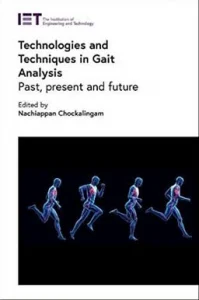
Technologies and Techniques in Gait Analysis is a book edited by Nachiappan Chockalingam
Gait analysis is the study of the walking or running pattern of an individual. This can include spatial and temporal measurements such as step length, stride length and speed along with angular measurements of various joints and the interplay between various parts like the foot, hip, pelvis or spine when walking. Gait analysis can be used to assess clinical conditions and design effective rehabilitation; for example, following limb injury or amputation, or other disorders such as a stroke or Parkinson’s diagnosis. It can be used to influence intervention decisions, such as whether a patient should undergo surgery, further physiotherapy, or begin a particular treatment regime. Gait analysis can also be used in sports science to monitor and review performance and technique.
Gait can be recorded in a variety of ways, including pressure sensors, force plates, in-shoe pressure systems, through marker-based or marker-less systems using various cameras or sensors to calculate body positions in a set sequence of movements.
This book focuses on both the hardware systems for collecting data as well as data visualisation and mathematical models for interpreting the data. It is written by a range of international researchers from academia, industry, and clinical settings, providing a complete overview of gait analysis technologies suitable for an audience of engineers in rehabilitation technologies or other biomedical engineering fields.




